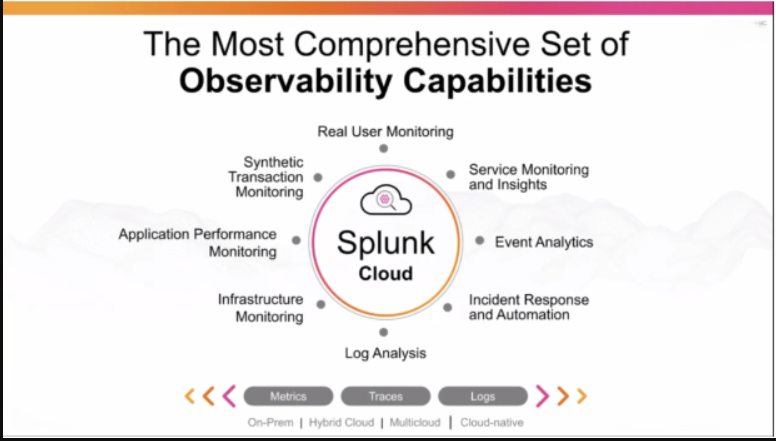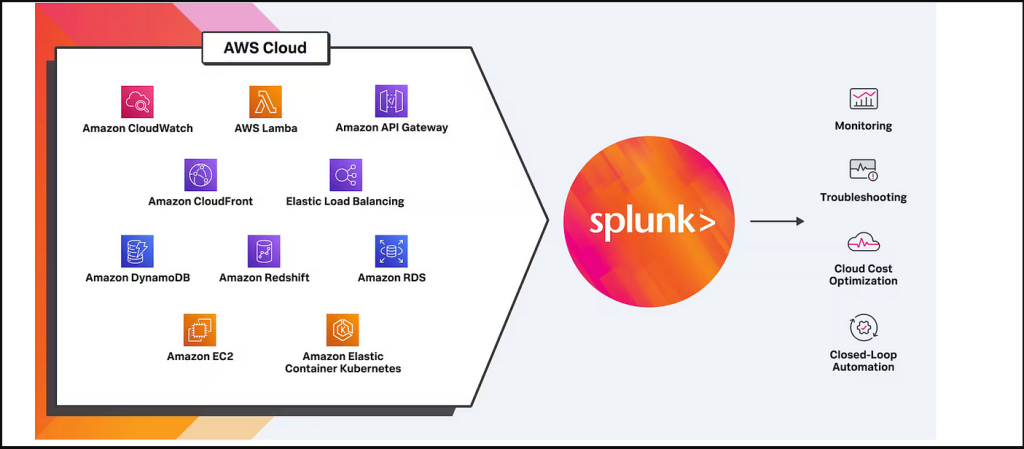Upgrade & Secure Your Future with DevOps, SRE, DevSecOps, MLOps!
We spend hours on Instagram and YouTube and waste money on coffee and fast food, but won’t spend 30 minutes a day learning skills to boost our careers.
Master in DevOps, SRE, DevSecOps & MLOps!
Learn from Guru Rajesh Kumar and double your salary in just one year.

In the dynamic world of software development and IT operations, real-time monitoring and observability have become essential for maintaining system performance and ensuring seamless user experiences. Splunk, a leader in data analytics, has integrated DevOps principles into its observability and monitoring tools to help organizations stay ahead of performance issues and optimize their infrastructure. By leveraging data from logs, metrics, and traces, Splunk enables DevOps teams to gain deep visibility into their systems, applications, and infrastructure, facilitating proactive issue detection and faster troubleshooting.
Splunk’s platform empowers teams with the tools they need to monitor the health of their applications, track user interactions, and optimize system performance across multiple environments. This post will explore how Splunk uses DevOps practices in monitoring and observability, focusing on its major features and how they contribute to more efficient and effective DevOps workflows.
How Splunk Implements DevOps in Monitoring
Splunk has integrated its powerful data analytics platform into the heart of DevOps monitoring, providing tools that empower teams to manage and maintain their systems with greater visibility and control. The ability to collect, analyze, and correlate data from multiple sources in real-time is critical for DevOps teams to identify and resolve issues before they affect users.
Key Elements of Splunk’s DevOps Monitoring:
- Unified Monitoring: Splunk provides a unified platform that brings together logs, metrics, and traces into a single interface. This ensures that DevOps teams can view all their system performance data in one place, streamlining troubleshooting and reducing the need for multiple tools.
- Real-Time Analytics: With Splunk, DevOps teams can monitor system performance in real-time. This capability enables immediate visibility into application and infrastructure health, allowing teams to detect issues before they escalate and impact users.
- Integration with CI/CD Pipelines: Splunk’s monitoring tools integrate seamlessly with CI/CD workflows, allowing teams to track the impact of code changes throughout the development lifecycle. This integration ensures that performance issues are identified early in the process, reducing the risk of failures during deployment.
- Full-Stack Observability: Splunk provides full-stack observability, covering infrastructure, applications, and user interactions. This holistic view helps DevOps teams better understand how all components of their environment interact and where potential issues may arise.

Major Features of Splunk’s Monitoring and Observability Tools
Splunk offers several key features that make it a valuable tool for DevOps teams looking to monitor and optimize system performance. These features allow teams to gain actionable insights, improve system reliability, and proactively address issues.
Key Features of Splunk:
- Log Management and Analytics: Splunk excels in log management, providing powerful search and analysis capabilities for log data. DevOps teams can collect logs from a variety of sources, including applications, servers, and network devices, and correlate them to identify issues.
- Metrics Monitoring: Splunk allows teams to monitor key metrics, such as response times, system load, and resource usage. By tracking these metrics over time, teams can identify performance trends and address issues before they impact service levels.
- Distributed Tracing and APM: Splunk’s Distributed Tracing capabilities allow DevOps teams to track the flow of requests across microservices, helping identify bottlenecks and performance degradation. Splunk also offers APM (Application Performance Monitoring) for deeper insights into application behavior.
- AI and Machine Learning for Anomaly Detection: Splunk’s platform uses AI and machine learning to automatically detect anomalies in system performance. By learning the normal behavior of applications and infrastructure, the platform can alert teams to abnormal conditions, allowing them to take corrective action before problems affect end-users.
- Custom Dashboards and Alerts: Splunk provides customizable dashboards that display the most relevant metrics and data for teams. Additionally, teams can set up alerts to notify them when performance thresholds are exceeded, ensuring quick remediation of any issues.
How Splunk Supports Proactive Issue Detection
One of the key strengths of Splunk’s monitoring and observability tools is their ability to help DevOps teams detect and address potential issues before they affect users. With advanced data analytics, machine learning, and real-time insights, Splunk provides the proactive monitoring capabilities necessary for maintaining system health.
Features for Proactive Issue Detection:
- Machine Learning-Powered Anomaly Detection: Splunk uses machine learning algorithms to detect anomalies in performance data. This allows the system to flag unusual patterns of activity, such as unexpected spikes in traffic or resource usage, which may indicate a performance problem or security threat.
- Predictive Alerts: Splunk allows teams to set up predictive alerts that warn of potential issues before they occur. For example, teams can receive an alert when resource usage is trending toward capacity limits, giving them time to scale their infrastructure or optimize their systems.
- Automated Incident Response: With Splunk, teams can automate responses to certain types of performance issues. For example, when an alert is triggered, Splunk can automatically scale resources, restart services, or send notifications to the relevant teams, ensuring faster issue resolution.
- Root Cause Analysis: Splunk enables teams to quickly perform root cause analysis by correlating logs, metrics, and traces. By understanding the root cause of issues, teams can implement effective fixes and prevent similar issues in the future.
Benefits of Using Splunk for DevOps Monitoring
Splunk’s monitoring and observability solutions offer numerous benefits for DevOps teams, from enhanced collaboration to improved system reliability. By providing deep insights into system performance and user behavior, Splunk helps organizations optimize their infrastructure and applications.
Key Benefits Include:
- Faster Troubleshooting: With Splunk’s real-time analytics and full-stack observability, DevOps teams can quickly identify the root cause of performance issues and address them before they affect users. This reduces downtime and improves the user experience.
- Improved System Reliability: By continuously monitoring systems and leveraging machine learning-powered anomaly detection, Splunk helps teams proactively address issues, ensuring that services remain available and reliable.
- Cost Optimization: Splunk helps teams optimize resource utilization by providing detailed insights into infrastructure performance. Teams can identify underutilized resources, reduce overprovisioning, and make data-driven decisions to reduce infrastructure costs.
- Collaboration Across Teams: Splunk’s platform enables collaboration between development, operations, and business teams. Shared dashboards, alerts, and insights help ensure that all stakeholders are informed and can work together to resolve issues quickly.
- Scalable and Flexible Solutions: Splunk’s tools are highly scalable, making them suitable for organizations of all sizes. Whether you are managing a small-scale application or a global distributed system, Splunk can handle large volumes of data and provide the performance needed to meet your monitoring requirements.
How Splunk Facilitates Continuous Improvement in DevOps
Continuous improvement is a fundamental aspect of DevOps, and Splunk’s monitoring tools are designed to support this process. By providing actionable insights, enabling automated workflows, and integrating with the CI/CD pipeline, Splunk helps teams iterate and improve their applications over time.
Features for Continuous Improvement:
- CI/CD Integration: Splunk integrates seamlessly with CI/CD pipelines, providing real-time visibility into application performance during the development, testing, and deployment phases. This allows teams to monitor the impact of code changes and quickly address any performance issues before they reach production.
- Performance Optimization: Splunk’s analytics capabilities help teams continuously optimize application performance. By monitoring key metrics, tracing requests, and analyzing log data, teams can identify areas for improvement and enhance the efficiency of their applications.
- Agile Monitoring: Splunk supports agile development by enabling teams to monitor changes and improvements over time. This ongoing monitoring ensures that DevOps teams can adapt to new requirements, fix bugs, and deploy new features with confidence.
- Data-Driven Decision Making: Splunk empowers DevOps teams with the data they need to make informed decisions. By analyzing historical performance data, teams can identify trends, optimize workflows, and continuously improve the performance and reliability of their systems.
Splunk’s Impact on DevOps Monitoring and Observability
Splunk’s powerful monitoring and observability tools are a valuable asset for DevOps teams looking to maintain high-performance applications, ensure system reliability, and optimize infrastructure. By offering full-stack observability, real-time data analytics, machine learning-powered anomaly detection, and seamless integration with CI/CD pipelines, Splunk enables teams to detect issues early, resolve them quickly, and continuously improve system performance.
With its scalable and flexible solutions, Splunk helps organizations of all sizes stay ahead of performance challenges and deliver reliable, high-quality software to their users. Whether you’re managing cloud infrastructure, microservices, or legacy applications, Splunk provides the insights and tools needed to monitor, troubleshoot, and optimize your systems effectively.

 Starting: 1st of Every Month
Starting: 1st of Every Month  +91 8409492687 |
+91 8409492687 |  Contact@DevOpsSchool.com
Contact@DevOpsSchool.com